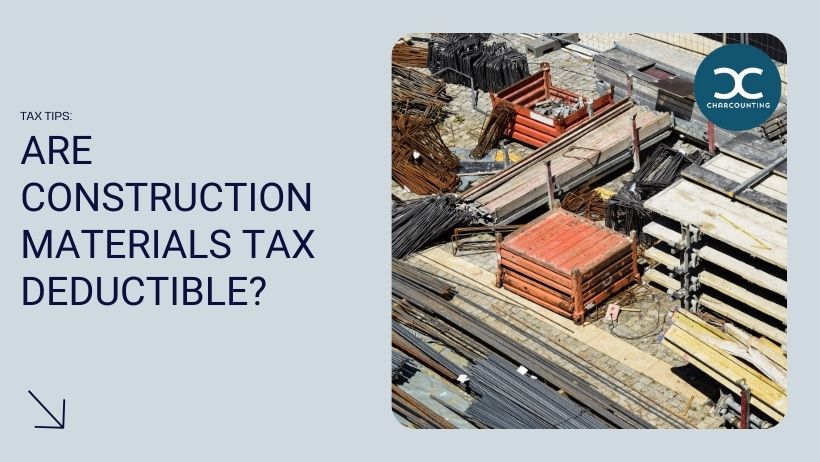magine your home as a canvas, with construction materials as the paint.
Much like paint turns a blank canvas into art, these materials transform your home into a personalized space. As you meticulously apply each ‘stroke’—installing new tiles or replacing an old roof—questions about the financial implications of such improvements hover, particularly regarding tax deductions. Strategic spending is essential.
Understanding Tax Deductibility
In the realm of personal finance, especially within homeownership, the nuances of tax deductibility are manifold. Tax deductions reduce your taxable income, potentially lessening your tax burden. However, not all expenses related to home improvements qualify for such benefits. The Internal Revenue Service (IRS) delineates specific scenarios under which construction materials may be eligible for tax deductions.
When assessing the eligibility of construction materials for tax deductions, one must appreciate the concept of “capital improvements.” These are enduring upgrades that increase the value of your home, prolong its useful life, or adapt it for new uses. Expenses on materials for such enhancements often qualify. On the flip side, materials for simple repairs or maintenance, which keep the property in good condition but do not add significant value, typically do not meet the stringent criteria for tax deductibility.
The Basics of Home Improvement Deductions
Home improvements can indeed impact your taxes, but only under certain circumstances. Tax regulations concerning these deductions distinguish between types of improvements.
Capital improvements, as defined by the IRS, exceed mere cosmetic enhancements and potentially qualify as tax-deductible. To be eligible, they must add value, prolong longevity, or adapt a home for new purposes.
Capital improvements can offset taxes when selling your home.
However sophisticated the tax code appears, if the materials purchased serve immediate repairs, they usually do not qualify as deductions. These costs intertwine with tax benefits only when the scope includes improvements that increase a home’s basis.
Eligible vs. Ineligible Expenses
Deductibility hinges on the expense’s nature.
Capital investments in your home, such as significant renovations or additions, will often qualify for tax deductibility. This is because they are seen as improvements that increase the property’s market value, extend its life, or adapt it for new uses. Consequently, such expenses can reduce the capital gains tax when the property is sold.
Repairs alone do not differentiate an expense.
Minor repairs and maintenance, while crucial for property upkeep, do not qualify. These activities are deemed to maintain current value rather than enhance it and, therefore, do not affect your home’s tax basis.
Certain enhancements meet strict criteria.
Consider the complexity of these tax matters – while a new roof may qualify for deductions, repainting rooms may not. It’s critical to discern between what’s considered maintenance versus an enhancement improving your property’s value.
Qualifications may extend beyond initial intent.
If an improvement, like energy-efficient upgrades, aligns with specific tax credits or deductions, its relevant expenses might be deductible. However, the exact nature of these tax benefits can fluctuate with changes in the tax code, requiring attentiveness to the current legislature.
Guidance from a tax professional is invaluable.
Navigating the nuances of home improvement deductions demands professional advice. A tax expert can help you understand the implications of your expenditures and ensure compliance with the latest tax codes, drastically improving the likelihood of beneficial outcomes.
Types of Construction Materials Covered
**Deductions can hinge on material classification.**Construction materials classified as improvements to your property could potentially be tax-deductible. Everyday eligible items include materials for significant renovations or additions that increase your home’s value, longevity, or utility.
**Interpret the tax code with precision.**Understanding which construction materials qualify requires careful interpretation of current tax laws. Generally, materials used in enhancements such as insulation, new windows, or structural additions may be eligible, provided they meet the IRS’s stringent capital improvement guidelines.
**Navigating the ‘permanent’ versus ‘temporary ‘**The divide between “permanent” improvements and “temporary” fixes is crucial; only the former typically offers the potential for tax deductions when addressing construction material costs.
Permanent Improvements
Understanding the distinctions surrounding construction accounting materials as capital improvements is imperative for tax deduction considerations. The Internal Revenue Service (IRS) distinguishes between upgrades that add value, prolong your property’s lifespan, or adapt it for new uses versus mere repairs.
From a taxation standpoint, materials purchased for permanent improvements can often be capitalized, meaning their cost is added to the property’s basis and depreciated over time. This contrasts with immediate write-offs typically associated with simple repairs or maintenance, which do not add significant value to the property.
To qualify as a permanent improvement, the work must go beyond mere upkeep and enhance, adapt, or restore the property’s function or structure. It’s crucial to meticulously document the nature of the upgrades, preserving invoices and receipts to substantiate these costs during tax filing.
The tax code’s criteria for capitalizing construction materials are deeply granular. They delve into the asset’s adjusted basis, improvements versus repairs, and property classification. As such, engaging with a tax professional specializing in real estate can provide invaluable guidance through this complex arena.
Recognizing these distinctions, business owners must approach their tax strategy for construction materials with due diligence and a comprehensive understanding of the IRS regulations. Deliberate planning and detailed record-keeping can unlock potential tax benefits of long-term property improvements.
Fixtures and Structural Components
The tax treatment of construction materials for fixtures and structural components can vary depending on context.
- Lighting systems, including fixtures and the electrical works supporting them
- HVAC units, which encompass the heating, ventilation, and air conditioning system
- Plumbing fixtures, such as sinks, toilets, and showers, including the associated piping
- Permanent floorings, like tiled or hardwood floors that are nailed or glued down
- Built-in appliances, which are integrated into the structure of the home
- Windows and doors, provided they are not simply replacements but upgrades to the property
Consequently, distinguishing between repairs and capital improvements is critical.
Materials that contribute to the capital improvement of your property may offer tax benefits.
Navigating the IRS Rules
Understanding the Internal Revenue Service (IRS) regulations surrounding construction materials for homeowner tax deductions can be intricate. The key is to discern whether the materials are utilized for repairs or constitute capital improvements. Capital improvements—which enhance the value of your home, prolong its life or adapt it for new uses—may qualify for tax benefits. Repairs, however, typically maintain current property conditions and often do not. Accurate classification is imperative as it directly impacts the eligibility for deductions. Homeowners must ensure that their documentation is precise, retaining receipts and records that delineate the nature of the work executed. Additionally, consulting with a tax professional can clarify the nuanced IRS provisions to ensure compliance and optimize potential tax deductions.
Capital Improvements Explained
Capital improvements constitute alterations that increase your home’s value and extend its useful life or adapt it for new utility, potentially translating into long-term tax advantages. Although it might seem vague at first, this broad definition encompasses a vast array of modifications ranging from substantial renovations to the addition of new structures.
When assessing whether an expense is a capital improvement, contrast it with ordinary repairs, which are typically non-deductible. Improvements often have a lasting effect on the property’s value, unlike repairs, which merely maintain the existing condition.
Furthermore, capital improvements must be permanent and increase the property’s inherent value—they are not merely maintenance or cosmetic updates. Examples include room additions, roof replacements, insulation installation, and building an attached garage or deck.
To qualify as a capital improvement, the work must attach to the property and stand the test of time, meaning it should remain for more than the immediate future. These enhancements must also adapt the home to new uses, such as converting an attic into a liveable space or improving its energy efficiency.
Remember, not all tangible upgrades to your property will qualify as capital improvements. Hence, understanding precise IRS criteria is crucial to determining whether your construction material costs are tax-deductible. Always consult a tax advisor to confirm eligibility and ensure compliance with current tax laws and regulations.
Record Keeping for Homeowners
Meticulous record-keeping is integral to substantiating tax deductions related to your home. It safeguards against potential tax discrepancies and bolsters your defense in case of audits. Documentation should be detailed, indexing every expense with clear links to the property enhancement.
Preserve all receipts, contracts, and permits associated with home improvements. These are pivotal pieces of evidence that determine the deductibility of your construction expenses.
When a home improvement spans several tax years, tracking expenditures across these periods is vital. Doing so ensures that the entire investment is accounted for and that no eligible deduction is overlooked. This is especially important for projects that are part of a multi-stage renovation or if you plan to claim the improvement depreciation over time.
In anticipation of future property sales, maintain meticulous records of all costs associated with capital improvements. These could reduce potential taxable gains upon sale and strengthen your financial portfolio by showcasing a history of responsible property investment and care. For this reason, consider employing digital tools or consulting professionals specializing in asset management and tax planning.
Special Cases and Exceptions
In specific instances where construction materials are utilized for medical purposes, such as the installation of ramps or widened doorways to accommodate a disability, the costs may qualify as deductible medical expenses. However, the deduction is subject to limitations, and homeowners must satisfy strict IRS criteria to claim these expenses.
Specific energy-efficient home improvements may also garner tax credits, reducing your tax liability directly rather than lowering taxable income. These credits apply to specific materials that meet government standards for energy efficiency and are subject to periodic updates and expiration dates.
Energy-Efficient Upgrades
Energy-efficient upgrades can yield significant tax advantages for homeowners.
- Insulation Materials: Adding or improving home insulation can qualify for a tax credit.
- Energy-Efficient Windows and Doors: Replacing old windows and doors with energy-efficient models might be eligible for tax savings.
- HVAC Systems: Installing or upgrading to a high-efficiency heating and cooling system may offer tax credits.
- Solar Energy Systems: Photovoltaic and solar water heating installations can attract substantial tax credits.
- Roofing: Certain reflective roofing materials designed to reduce heat gain may qualify for tax benefits. These improvements must adhere to the energy efficiency standards set by the IRS.
Remember, proper documentation and adherence to IRS regulations are paramount to utilizing these tax credits.
Repairs vs. Improvements Distinction
When homeowners weigh the tax implications of their construction material expenses, it is crucial to distinguish between repairs and improvements. This distinction directly affects deductible eligibility.
Repairs are typically maintenance-based actions intended to restore property functionality without enhancing its value or prolonging its life.
On the other hand, improvements are capital expenditures that increase a property’s value, extend its useful life, or adapt it for new purposes, thus potentially qualifying for tax advantages.
Understanding this distinction is vital for homeowners as improvements can be capitalized and depreciated over time, whereas repairs might be immediately deductible in the year they were paid. This classification discernment affects the overall tax strategy and planning for property-related expenses.
How do I determine if certain construction materials are tax deductible?
Determining if certain construction materials are tax deductible requires carefully understanding the tax laws and regulations about business expenses. It is recommended to consult a qualified tax professional or accountant to ensure accurate and compliant deductions. However, here are a few key points to consider when evaluating the tax deductibility of construction materials:
- Purpose: Determine if the construction materials are being used for a business-related purpose. If they are necessary for the operation, maintenance, or improvement of your business property, they are more likely to be considered tax deductible.
- Ordinary and Necessary: The IRS requires that the expense is ordinary and necessary for your business. In other words, construction materials should be customary and ordinary within your industry, and their purchase should be considered essential for your business operations.
- Capital Improvements vs. Repairs: It’s essential to differentiate between capital improvements and repairs. Capital improvements, such as adding extensions or significant upgrades, are typically depreciated over time and may have different rules regarding tax deductions. On the other hand, repairs and maintenance expenses, including the cost of construction materials, may be fully deductible in the year incurred.
- Documentation: Keep detailed records of all construction material purchases, including receipts, invoices, and contracts. This documentation is crucial to support your tax deductions and provide evidence of the expenses incurred.
- Energy Efficiency Incentives: Some construction materials, particularly those that enhance energy efficiency, may qualify for additional tax incentives or credits. Examples include solar panels, energy-efficient windows, or insulation. Familiarize yourself with the specific requirements and eligibility criteria to maximize potential tax benefits. Remember, tax laws can be complex and subject to change. Working with a knowledgeable tax professional will help you accurately interpret the regulations and take full advantage of any available tax deductions for construction materials.
Are there any limitations or restrictions on deducting construction materials from taxes?
When deducting construction materials from taxes, it’s essential to be aware of certain limitations and restrictions. The Internal Revenue Service (IRS) has specific guidelines determining what can be deducted and to what extent.
One fundamental limitation to consider is the distinction between current and capital expenses. Current expenses are typically fully deductible in the year they are incurred, while capital expenses may need to be depreciated over time.
Construction materials used to repair or maintain existing business property may be considered current expenses and thus deductible in the year they are paid or incurred. However, if the materials are used to improve or add value to the property, they may be classified as capital expenses and subject to different deduction rules.
Additionally, there are specific rules regarding the deduction of certain construction materials. For example, there are limitations on the deduction of luxury items, such as high-end fixtures or finishes, that may be considered excessive or extravagant.
It’s also important to note that any deductions must be directly related to the business and necessary for its operation. This means that personal or non-business expenses cannot be deducted.
To ensure compliance with tax regulations and maximize your deductions, consulting with a qualified tax professional or accountant specializing in construction-related deductions is highly recommended. They can provide guidance specific to your situation and help you navigate the complexities of the tax code.
Remember, accurate record-keeping is essential when deducting construction materials from taxes. Keep detailed records of all purchases, receipts, and invoices to support your deductions in case of an IRS audit.
In Conclusion
while there are limitations and restrictions on deducting construction materials on taxes, with proper planning, documentation, and expert advice, you can maximize your deductions and ensure compliance with the tax laws.






